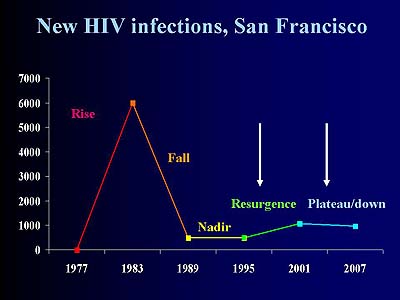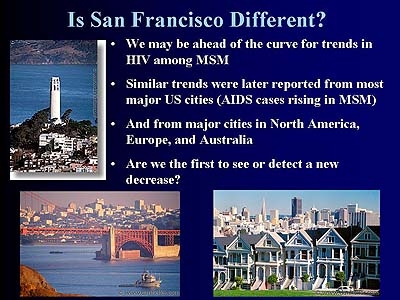 (Lawrence K. Altman, sometimes known as the CDC's stenographer for the NY Times.)
(Lawrence K. Altman, sometimes known as the CDC's stenographer for the NY Times.)Epigraph No. 1
"These are sub-Saharan African levels of transmission."
Dr. Willi McFarland, SF Chronicle, Page 1, June 30, 2000
Epigraph No. 2
Dr. Ronald O. Valdiserri, an AIDS expert at the federal Centers for Disease Control and Prevention in Atlanta, said his agency had not reviewed the San Francisco findings. But, if confirmed, the findings "are very serious and important," Dr. Valdiserri said in an interview.
Dr. Valdiserri said he did not "want to be alarmist about a national resurgence" of H.I.V. But, he went on, "we have been trying to sound the alarm about the misperception that the AIDS epidemic is over and not an issue any more."
Lawrence K. Altman writing on the front-page of the NY Times, July 1, 2000.
* * *

Back on November 29, 2006, Dr. Willi McFarland, HIV epidemiologist for the San Francisco health department, presented his latest research and findings at a Grand Rounds forum at the SF General Hospital, but his forty-four PowerPoint slides were not made publicly available on the web until this week.
What is the HIV stats news today from the USA's AIDS Model City? New HIV infections for 2007 are projected to continue in a "plateau/down" phase.
(Sounds like medical news to me, maybe even from the mainstream press and the reporters who so breathlessly, and unquestioningly a few years ago were reporting an alarming surge of out-of-control HIV transmissions in SF's gay community. Hello, Dr. Altman, are you no longer interested in HIV stats from SF, or, is it you're only going to write about them when they're supposedly up and your pals at CDC need you to serve as mouthpiece for the agency, your former employer? But I disgress.)

This slide shows a slight resurgence of infections, a surge that ever since it was first alleged I have been extremely skeptical of, largely because of previous instances of HIV/AIDS/STD statistical manipulation by the SF DPH, but now, if only for argument's sake, I want to accept the proposition that there was a genuine, essentially marginal, rise of new HIV infections in 2000/2001.
Assuming that the rise occurred, why did it happen, given that so many gay men with AIDS were on drug cocktails, hence a reduced viral load and less likely to transmit HIV to an uninfected partner, and that a vast number of gay PWAs were serosorting, only sexually active with other PWAs, why did infections increase?
The answer appears to be that because drug cocktails were extending the lives of large numbers of PWAs, many of them sexually active again, the blip of a rise in 2000/2001 took hold.

This slide says that the success of drug cocktails, leading to longer lives, meant more positives out there engaging in sex. Also, if you listen to the RealPlayer audio portion of McFarland's presentation, at about 24:00 minutes into his talk, he explains this line of reasoning.

In 2000, when the "sub-Saharan African levels of transmission" claim was made, a UCSF researcher said the following to the SF Chronicle:
"This is a harbinger of what is going to happen all over the country," warned Tom Coates, director of the University of California at San Francisco AIDS Research Institute. `"What happens in the HIV epidemic usually happens here first."
When SF DPH officials were first publicly recognizing a plateau and drop in new infections after 2000/2001, they and UCSF and CDC experts never said if the decrease was also occurring all over the nation, like they claimed when the numbers were surging.
McFarland broaches in his talk the question of is San Francisco the first city to see a plateau/down phase, and he answers with a "maybe" response. He speaks about this question starting at the 34:45 minute mark.

Interesting conclusions drawn by McFarland, wouldn't you say? Of keen interest to me is his hypothesis that serosorting, which he accurately describes as community-organized, plays a key role in stopping HIV in San Francisco.
It amazes me that SF DPH and AIDS Inc are finally getting around to formally proclaiming how the sexual practice of serosorting, which they have not created or fully endorsed, is a crucial component to HIV prevention because this acknowledgement is something of a condemnation about official prevention programs and messages.
In other words, without the assistance of the millions in federal and local prevention dollars and community groups, gay PWAs through serosorting have contained an epidemic. Maybe if there less interference in the sex lives of gays and PWAs, especially a reduction in hysterical and violent social marketing campaigns and fewer alarmist claims about second- and third-waves, and were we left alone to own devices of loving and not infecting others, we might do even better at reducing HIV infections even further.
Also, since it doesn't seem to have crossed anyone's mind at SF DPH or working for AIDS Inc to congratulate gay men and PWAs for the remarkable HIV control, or anyway offer us a pat on the collective or give positive reinforcement to behaviors clearly shown on our part, I'd like to suggest the experts consider finding the strength to give gay men the credit we deserve on this.
So where is the NY Times story by Lawrence K. Altman on all this good news, particularly the SF DPH projection that 2007 will see the continued phase of plateau/down HIV infections here? I hope it is not necessary for Altman and the science desk at the NY Times to be spoon-fed HIV stats from either SF DPH or CDC in order for the paper to give readers a sense of current rates in San Francisco.
###

HIV Information
If you need HIV information or help with AIDS questions, visit this great site. You can also find what you need at Tuft's for HIV health.

No comments:
Post a Comment